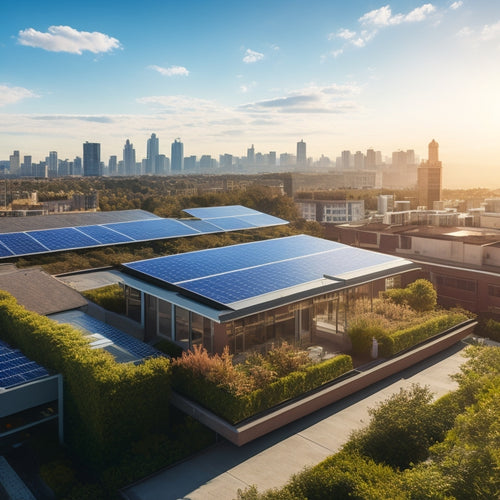
Why California Requires Permits for Home Solar Installations
Share
You're installing solar panels at home in California and wondering why you need permits. The state requires permits to make sure your system meets strict electrical safety standards, building code requirements, and environmental regulations. This protects you, your property, and the grid from potential hazards. By obtaining the necessary permits, you'll guarantee compliance with utility requirements, prevent electrical shocks and fires, and minimize air quality hazards. You'll also avoid costly installation delays and make certain your system is installed correctly. To understand the ins and outs of California's permitting process, let's delve into the details.
Key Takeaways
• California requires permits to ensure compliance with building codes, electrical safety standards, and environmental regulations for solar installations.
• Permits guarantee that solar installations meet strict electrical safety standards, reducing the risk of electrical shocks, fires, and other hazards.
• The permitting process involves obtaining approvals from local authorities, ensuring that solar installations meet California's stringent building code requirements.
• Permits safeguard air quality by ensuring compliance with emissions standards, and regular maintenance encouraged by permits maintains clean air standards.
• Obtaining a permit guarantees compliance with utility requirements, ensuring a safe and efficient grid connection for home solar installations.
Understanding California's Permitting Process
You'll need to navigate California's permitting process, which involves obtaining approvals from local authorities and complying with state and national electrical and building codes, before installing solar panels on your home. Don't worry, it's not as intimidating as it sounds!
Understanding the permit history is important to a smooth installation process. In California, permits have been required for solar installations since 2004, with the goal of ensuring safe and efficient systems.
To increase your chances of approval, follow these application tips: submit complete and accurate plans, make sure your installer is licensed and certified, and be prepared to address any potential concerns from local authorities. By doing your due diligence, you'll be generating clean energy in no time!
Ensuring Electrical Safety Standards
When installing solar panels, guaranteeing electrical safety standards is essential to prevent electrical shocks, fires, and other hazards, and California's electrical codes and regulations are in place to ensure a safe and reliable solar installation. You don't want your dream of going green to turn into an electrical nightmare!
To avoid Electrical Hazards, California requires solar installers to follow strict Safety Protocols. These protocols ensure that your solar installation meets the highest electrical safety standards. Here are some key aspects of these protocols:
-
Proper Wire Sizing: Ensuring wires are sized correctly to handle the electrical load, reducing the risk of overheating and fires.
-
Grounding and Bonding: Guaranteeing that all electrical components are properly grounded and bonded to prevent electrical shocks.
-
Disconnects and Overcurrent Protection: Installing disconnects and overcurrent protection devices to prevent electrical surges and overloads.
Meeting Building Code Requirements
When installing solar panels on your California home, you'll need to confirm that your system meets building code requirements. This involves complying with code standards, checking the structural integrity of your roof, and implementing electrical safety protocols to prevent hazards.
Code Compliance Standards
Your California home solar installation must meet the state's stringent building code requirements, which are outlined in the California Building Code (CBC) and the California Residential Code (CRC).
As you navigate the permitting process, understanding the codes and standards that govern solar installations is crucial. Code compliance is vital to guarantee your system is safe, efficient, and meets the state's high standards.
To help you stay on track, here are three key aspects to focus on:
-
Code Evolution: Stay up-to-date with the latest code revisions, as they can impact your installation. For instance, the 2019 CBC introduced new requirements for solar panel installations.
-
Compliance Incentives: Take advantage of state and local incentives for code-compliant installations, such as rebates and tax credits. These can help offset the cost of your solar investment.
-
Inspection Readiness: Ensure your installation is inspection-ready by following the CBC and CRC guidelines. This will save you time and money in the long run by avoiding costly rework or corrections.
Structural Integrity Checks
During the solar installation process, you'll need to carry out thorough structural integrity checks to guarantee that your California home's roof and underlying structure can support the added weight and stress of solar panels, meeting the stringent building code requirements outlined in the CBC and CRC.
These checks confirm your roof's durability and foundation stability aren't compromised by the solar panels. You wouldn't want your roof to cave in or your foundation to shift, right? That'd be a real solar-powered nightmare!
Here's a breakdown of the key structural integrity checks:
| Check | Description | Purpose |
|---|---|---|
| Roof inspection | Visual examination of roof condition | Identify potential weaknesses or damage |
| Load calculation | Calculate weight and stress on roof | Ensure roof can support solar panel weight |
| Foundation assessment | Evaluate foundation stability and integrity | Guarantee foundation can handle added weight |
| Structural analysis | Analyze roof and foundation interaction | Identify potential stress points and weaknesses |
Electrical Safety Protocols
Now that your California home's roof and underlying structure have been deemed solar-ready, it's time to focus on guaranteeing the electrical safety of your solar installation. This involves meeting the stringent electrical safety protocols outlined in the California Building Code (CBC) and California Residential Code (CRC).
As you navigate the permitting process, you'll need to demonstrate compliance with electrical safety standards. This includes safeguarding your system from Arc Faults, which can cause electrical fires, and Overvoltage, which can damage your equipment.
Here are some key electrical safety protocols to keep in mind:
-
Grounding and bonding: Ensure all electrical components are properly grounded and bonded to prevent electrical shock.
-
Circuit protection: Install circuit breakers or fuses to prevent electrical overloads and short circuits.
-
Electrical insulation: Verify that all electrical connections and cables are properly insulated to prevent electrical shock and fires.
Environmental and Health Concerns
As you navigate the process of obtaining a California home solar installation permit, you'll need to take into account the environmental and health implications of your project.
You'll want to make sure that your solar installation doesn't compromise air quality, which is a critical concern in California.
Air Quality Protection
Protecting air quality is essential in California, where solar installations can inadvertently contribute to environmental and health concerns if not properly planned and executed. As you consider installing solar panels on your California home, you mightn't think about the impact on air quality. However, it's vital to make sure that your solar installation doesn't compromise the fresh breeze Californians love.
Here are a few ways permits help safeguard air quality:
-
Emissions control: Permits ensure that solar installations comply with California's stringent emissions standards, preventing harmful pollutants from entering the atmosphere.
-
Proper equipment installation: By regulating equipment installation, permits guarantee that solar panels and inverters are installed correctly, minimizing the risk of chemical leaks or other air quality hazards.
-
Regular maintenance: Permits encourage regular maintenance, ensuring that your solar installation continues to operate efficiently and safely, without compromising clean air standards.
Toxic Chemical Prevention
When installing solar panels on your California home, you'll want to make sure that toxic chemicals are prevented from contaminating soil and groundwater, as well as minimizing the risk of exposure to hazardous materials during the installation process. California's permit requirements guarantee that solar installers follow strict guidelines to prevent chemical exposure and hazardous waste generation.
| Hazardous Materials | Risks | Prevention Measures |
|---|---|---|
| Lead and cadmium | Toxicity, environmental contamination | Proper disposal, containment, and recycling |
| Chemical cleaning agents | Skin and respiratory irritation | Safe handling, ventilation, and personal protective equipment |
| Heavy metals | Groundwater contamination, ecosystem disruption | Secure storage, leak prevention, and spill response plans |
| Electrical components | Electrocution, fire hazards | Proper installation, insulation, and maintenance |
Permitting for Grid Connection
You'll need to obtain a grid connection permit from your utility company before installing a grid-tied solar panel system in California. This permit guarantees that your system meets the utility company's interconnection requirements and won't disrupt the grid. Think of it like getting a permission slip to join the energy-sharing party!
Here are a few key considerations for grid connection permitting:
-
Grid Capacity: The utility company needs to make sure that the grid can handle the extra energy your solar panels will produce. They'll assess the grid capacity in your area to ensure a smooth connection.
-
Energy Storage: If you're planning to install energy storage systems like batteries, you'll need to provide details on how they'll interact with the grid.
-
System Design: Your solar panel system design must meet the utility company's technical requirements, including voltage, current, and power quality standards.
Avoiding Costly Installation Delays
To prevent costly installation delays, it is vital to identify and address potential issues early on in the permitting process. You don't want to be stuck waiting for approvals while your project timelines slip further and further behind. And let's be real, who needs the added stress of budget overruns?
To avoid these headaches, it's imperative to get your permits in order. Here's a breakdown of what you should focus on:
| Permitting Stage | Potential Delays | Solution |
|---|---|---|
| Plan submission | Incomplete or inaccurate plans | Verify plans with local authorities before submission |
| Plan review | Lack of clarity on requirements | Clarify requirements with local authorities before submission |
| Inspection scheduling | Inadequate inspection scheduling | Schedule inspections in advance to guarantee timely completion |
Frequently Asked Questions
Can I Install Solar Panels on a Rented Property?
Before installing solar panels on a rented property, you'll need to get your landlord's approval, which may involve revising your rental agreement to confirm both parties are on the same page.
Do I Need a Permit for a Small Solar Panel System?
You'll likely need a permit for your small solar panel system, as local codes typically require permits for systems over a certain size, so check the system size and local regulations before installing.
Can I Install Solar Panels on a Historic Home?
When installing solar panels on a historic home, you'll need to guarantee that the system preserves the property's historic significance and architectural integrity, so be prepared to work closely with local preservationists and permitting authorities.
How Long Does the Permitting Process Typically Take?
You're wondering how long the permitting process takes? Well, buckle up! The permit timeline varies, but typically takes 2-6 weeks, depending on application complexity, government efficiency, and the likelihood of processing delays and bureaucratic hurdles.
Can I Get a Permit for a DIY Solar Panel Installation?
"As a DIY enthusiast or solar rookie, you'll likely need a permit for your DIY solar panel installation, but check with your local authorities, as they'll determine if your project requires a permit, and don't worry, it's not rocket science... yet!"
Related Posts
-

5 Essential Tips for Buying EV Charging Systems Online
When purchasing an EV charging system online, you'll want to make sure you're making an informed decision. First, det...
-

Why Nearby EV Conversion Shops Matter to You
Having a nearby EV conversion shop means you'll experience the benefits of a more personalized, convenient, and susta...
-

What Is the Cost to Put in Solar Panels
You're likely considering solar panels for your home, and the most significant factor in your decision is the upfront...


